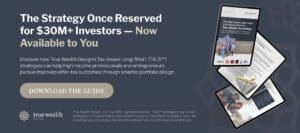Tax-loss harvesting is often misunderstood. Some investors see it as a quick fix for bad performance. Others think it is an opportunistic move to make only in volatile markets.
Effective tax-loss harvesting is a strategic tool, not a reaction to short-term market swings. This is especially true when working with factor-based portfolios, where the mechanics of replacement securities require more precision.
When done correctly, tax-loss harvesting reduces your tax bill in the short term while keeping your long-term investment strategy intact. However, if done reactively, it risks disrupting your portfolio’s design and undermining the factors you are trying to capture.
What is tax-loss harvesting?
Tax-loss harvesting is an investment strategy used to minimize capital gains taxes. It involves selling investments that have declined in value to below their purchase price to realize a loss. These losses can then be used to offset gains from other investments or to reduce taxable income.
It can help you lower your overall tax liability while allowing you to reinvest the proceeds in other opportunities.
It’s important to adhere to IRS rules regarding wash sales when implementing this strategy.
Why tax-loss harvesting matters
The benefits of tax-loss harvesting can be meaningful over time. By deferring gains and reinvesting the tax savings, you effectively get an interest-free loan from the government. That capital can continue working for you in the market until you realize the gains.
While the tax bill is only postponed, not eliminated, the time value of money can make this a powerful strategy.
Factor-based portfolios add complexity
Factor-based investing aims to capture long-term return premiums associated with characteristics like value, size, momentum, quality, and profitability. Investors allocate to factors expecting these exposures to deliver excess returns over long periods, even if they lag the broader market for years.
The holdings in a factor portfolio are carefully constructed to target these exposures. When you sell part of the portfolio to harvest a loss, you must replace it with something that maintains similar factor tilts without triggering the wash sale rule. The challenge is that traditional index fund swaps may not be sufficient to preserve the intended exposures.
A poorly executed harvest can dilute your factor tilts, potentially lowering your expected returns. The more precise the portfolio’s design, the more critical it becomes to choose a replacement that respects the original exposures.
Avoiding the wash sale trap
The IRS wash sale rule disallows a loss if you buy a “substantially identical” security within 30 days before or after the sale. While the rule is relatively straightforward for individual stocks, it becomes more nuanced for ETFs and mutual funds. Two funds may track different indexes but still have enough overlap to risk disqualification.
This risk is higher in factor-based portfolios. If two funds use the same index provider or a very similar factor methodology, the IRS could view them as substantially identical. Even if they differ slightly in construction, a high degree of overlap in holdings could raise issues.
To reduce this risk, advisors often select a replacement fund that uses a different index provider, a different factor definition, or a distinct weighting methodology. While there is no bright-line test, the goal is to make a good-faith effort to avoid substantial identity while preserving the desired exposure.
Smart replacement strategies
The most straightforward replacement strategy in a broad index portfolio might be to swap an S&P 500 ETF for a total market ETF or a different large-cap index. In a factor-based portfolio, the replacement must still capture your target factor premium.
For example:
- Selling a U.S. small-cap value ETF that tracks the Russell 2000 Value Index might be followed by buying a small-cap value ETF tracking the S&P 600 Value Index.
- Replacing a profitability-weighted large-cap ETF could involve selecting another fund with a quality or profitability tilt but from a different provider.
- Swapping a momentum ETF for one that uses a different rebalancing schedule or factor ranking approach can preserve exposure while avoiding substantial identity.
These swaps require a detailed understanding of each fund’s methodology, holdings, and construction rules. The goal is to stay invested in the factor without materially changing the portfolio’s long-term objective.
Harvesting opportunities throughout the year
Many investors look for tax-loss harvesting opportunities in December, but losses can be harvested anytime. Factors can go through extended periods of underperformance relative to the market. Value stocks, for example, lagged growth stocks by an average of 7.8% annually for much of the decade starting in 2011. Momentum can also underperform in sudden market reversals. These cycles can create harvesting potential well before year-end.
A year-round monitoring process allows you to capture losses when they occur, rather than waiting for the traditional “tax season” window. This can also reduce the risk of executing too many trades at once in December, when spreads can widen and liquidity may be lower.
Maintaining factor discipline
One of the most significant risks of reactive tax-loss harvesting is unintentionally altering the portfolio’s factor exposures. Selling a factor-based ETF without a proper replacement could leave you holding a generic market index, diluting the portfolio’s intended strategy. Even worse, you might unintentionally increase exposure to factors you intended to avoid.
Balancing tax benefits with transaction costs
Tax-loss harvesting isn’t free. Every trade has costs, including bid-ask spreads, potential market impact, and deviations from target exposures during the settlement period. If the replacement fund is less liquid or more expensive, those costs can erode the tax benefit.
The decision to harvest should weigh the present value of the expected tax savings against these costs. Even with higher costs, a large unrealized loss might still be worth harvesting, while a small loss might not justify the disruption.
The role of tracking error
Harvesting can temporarily increase tracking error measured against the target benchmark or the original factor index in factor-based portfolios. For example, if you swap one small-cap value fund for another with slightly different factor definitions, the performance could diverge. This short-term divergence is usually acceptable as long as the exposures remain consistent with your long-term plan.
However, if the tracking error becomes too large or persists beyond the wash sale period, it may indicate that the replacement fund is not a suitable match.
Integrate harvesting into a broader tax strategy
Tax-loss harvesting shouldn’t be viewed in isolation. It works best when coordinated with other tax planning strategies, like:
Asset location : Placing tax-inefficient assets in tax-deferred or tax-free accounts.
Charitable giving of appreciated securities : Donating investments with gains to realize a tax deduction and avoid capital gains taxes.
Gain harvesting : Realizing gains in low-income years to reset cost basis without incurring significant tax.
Managing holding periods : Be mindful of short-term versus long-term gains because short-term gains are taxed at higher rates.
In a well-managed factor-based portfolio, harvesting is just one of several tools working together to improve after-tax results.
The mindset shift: proactive, not reactive
Tax-loss harvesting is most effective in factor-based investing when planned, systematic, and exposure-aware.
Reacting emotionally to short-term losses can undermine the very factor you are trying to capture. A disciplined approach focuses on preserving investment integrity while capturing tax benefits.
This requires preparation, not improvisation. It means having a list of replacement securities ready, monitoring exposures continuously, and making harvesting decisions based on data, not headlines.
When executed this way, tax-loss harvesting is a disciplined practice that works in harmony with the portfolio’s long-term design. It helps you keep more of what you earn while staying true to your investment philosophy.



